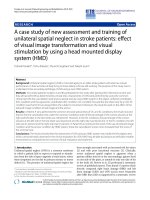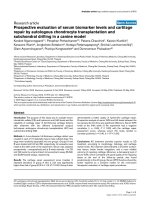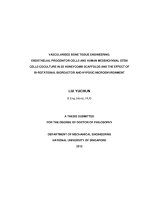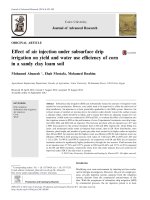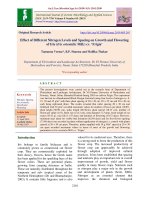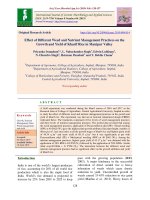Effect of different nitrogen levels and plant geometry on yield and nutrient uptake by brown top millet [Brachiaria ramosa (L.)]
Bạn đang xem bản rút gọn của tài liệu. Xem và tải ngay bản đầy đủ của tài liệu tại đây (246.11 KB, 7 trang )
Int.J.Curr.Microbiol.App.Sci (2019) 8(3): 223-229
International Journal of Current Microbiology and Applied Sciences
ISSN: 2319-7706 Volume 8 Number 03 (2019)
Journal homepage:
Original Research Article
/>
Effect of Different Nitrogen Levels and Plant Geometry on Yield and
Nutrient Uptake by Brown Top Millet [Brachiaria ramosa (L.)]
Ashwani Kumar Thakur1*, Prafull Kumar2 and Prahlad Singh Netam3
1
Department of Agronomy, SG College of Agriculture and Research Station, Jagdalpur, India
2
Department of Genetics and Plant Breeding, SG College of Agriculture and Research
Station, Jagdalpur, India
3
Department of Plant Pathology, SG College of Agriculture and Research Station,
Jagdalpur, India
*Corresponding author
ABSTRACT
Keywords
Brown top millet,
Nitrogen level,
Geometry, Yield,
NPK content and
Uptake
Article Info
Accepted:
04 February 2019
Available Online:
10 March 2019
Experiment was conducted during Kharif season 2018 at New Upland Research Station
cum Instructional Farm, Lamker under SG college of Agriculture and Research Station,
Jagdalpur, Bastar (CG). The experiment was laid out in split plot design with three
replications. Main plot was three levels of fertilizer i.e. F1 (75% RDF), F2 (100% RDF)
and F3 (125% RDF), and sub plot was four different spacing viz. S1 (22.5 x 10 cm), S2 (30
x 10 cm), S3 (45 x 10 cm) and S4 (60 x 10 cm). Grain yield, fodder yield per plot and per
ha was recorded significantly highest in F3 among fertility levels. In case of different
planting geometry, S4 recorded significantly higher grain yield but it was at par with S3
and S2. Fodder yield recorded significantly maximum in treatment S1 which was on par
with S2 and S3. NPK content in grain and straw recorded significantly higher in treatment
F3 (125% RDF) but it was on par with F2 (100% RDF) in N and P content in grain. In case
of different planting geometry, S4 (60 x 10 cm) recorded statistically higher P content in
straw which was at par with treatment S3.Treatment F3 recorded significantly higher NPK
uptake in grain, straw and total uptake among fertility treatments but in case of different
geometry, S4 recorded higher NK uptake in grain which was on par with S3 and S2.
millet, called korale in Kannada, is specially
grown in rainfed tracts of Tumakuru,
Chitradurga and Chikkaballapura districts of
Karnataka state. The crop is popular in this
region in terms of cultivation and
consumption. This millet seed is grown in a
variety of soils and climates. Like other
millets, it is a hardy crop and well suited for
dry land (Bhat et al., 2018). Brown top millet
is an annual warm-season species that grows
1 to 3 ft tall. The smooth stems have
pubescent nodes and may stand erect or
Introduction
Brown top millet [Brachiaria ramosa (L.)
Stapf; Panicum ramosum L.] is an introduced
annual grass that originated in South-East
Asia. It is grown in Africa, Arabia, China and
Australia, Clayton et al., (2006). It was
introduced to the United States from India in
1915 (Oelke et al., 1990). In the US, it is
mainly grown in the South-East for hay,
pasture and game bird feed. The browntop
223
Int.J.Curr.Microbiol.App.Sci (2019) 8(3): 223-229
ascend from a decumbent base. The leaves are
2.2 to 18cm long and 6-18mm wide; both
surfaces are smooth. The inflorescence is
indeterminate, open, spreading with simple
axis and stalked flowers. It has 3-15
inflorescences and white flowers. Seeds are
ellipsoid and tan in colour; they mature in
approximately 60 days (Sheahan 2014).
Brown top millet, which goes by the scientific
name Brachiaria ramosa (L.) Stapf. or
Urochloa ramosa (L.) R.D. Webster is known
locally as pedda-sama and korne, and has a
limited cultivation largely confined to
southern India. Domestic and wild/weedy
forms of brown top millet are found in
agricultural systems, often within the same
field. It is used as both a human food crop and
fodder. Outside of India, it is grown in some
parts of the USA as a fodder crop, largely to
provide food for game birds, and was
introduced from India around 1915. Although
its distribution is highly relict today, restricted
to parts remote parts of Andhra Pradesh,
Karnataka, and Tamil Nadu states in southern
India (Kimata et al., 2000), it appears to have
been a major staple crop in the late prehistory
of the wider region of the Deccan (Fuller et
al., 2004). Panicle is distinct from Setaria by
being looser and non-bristly, the grains
themselves are very similar. Grains are ovate
to round and have a long embryo, roughly two
thirds to three fourths of the length of the
grain. They tend to be smaller than Setaria
italica and squatter in cross section. The
surface of well-preserved grains can be used
for identification as these have a distinctive
undulating pattern, although this again has
similarities to S. italica (Fuller et al., 2004).
The husk has a fine beaded and rugose
pattern, which again has some resemblance to
that of Setaria spp., but it is somewhat coarser
than S. italica and finer than. S. verticillata
( />351352). The productivity of brown top millet
can be increased by applying of fertilizers.
The presence of organic manure along with
inorganic fertilizers helps in better availability
of nutrients and moisture. Besides these, other
advantages are reduction in seed rate, easy
inter cultivation, better weed management and
drip irrigation can also be adopted by
providing wider spacing than the conventional
method of planting (Prakasha et al., 2018).
The present investigation was taken to
develop a suitable nutrient management
packages under upland condition. For that
reason this research was undertaken to find
out an optimum level of chemical fertilizer
like urea and Di-Ammonium Phosphate
(DAP) that can maximize growth characters,
fodder and grain yield production of brown
top millet under climatic and soil conditions
of Bastar Plateau Zone of Chhattisgarh, India.
Materials and Methods
Experiment was conducted during Kharif
season 2018 at New Upland Research Station
cum Instructional Farm, Lamker under SG
college of Agriculture and Research Station,
Jagdalpur, Bastar, CG. The experiment was
laid out in split plot design with three
replications. Main plot was three levels of
fertilizer ie. F1 (75% RDF), F2 (100% RDF)
and F3 (125% RDF), and sub plot was four
different spacing viz. S1 (22.5 x 10 cm), S2
(30 x 10 cm), S3 (45 x 10 cm) and S4 (60 x
10 cm). Recommended dose of fertilizer was
40:20:00 kg N: P: K kg ha-1. The soil was
stony and calcareous in texture, low in
organic carbon (0.48%). available N (213.4
kg ha-1), available phosphorus (12.50 kg ha-1)
and medium in available potassium (228.6kg
ha-1) with soil reaction (pH 5.5). Olsen’s
method (Watanabe and Olsen, 1965), Neutral
normal Ammonium Acetate extract using
flame photometer (Hanway and Heidel, 1952)
and Walkely and Black method (Jackson,
1967) for the determination of available
nitrogen (N), phosphorus (P2O5) potassium
(K2O) and organic carbon, respectively. The
pH of experimental site was determined
224
Int.J.Curr.Microbiol.App.Sci (2019) 8(3): 223-229
through 1:2.5 soil and water suspension
method (Jackson, 1967).Weather during
kharif 2018 weekly pattern of different
meteorological parameters are shown in
figure 1 during kharif 2018. Total 1386.50
mm rainfall was recorded against the normal
rain fall of 1414.92 mm. Monsoon was active
during 24th SMW and received 26.04 mm
water with two rainy days. Maximum rainfall
was received during 29th SMW (130.7mm
with 4 rainy days), 32th SMW (109.9mm with
5 rainy days), 33th SMW (152.7mm with 5
rainy days) and 38th SMW (175.7 mm with 6
rainy days). During cropping season
maximum temperature was 34.5oC on 22nd
SMW and minimum temperature was
recorded 20.40oC on 38th SMW. The data
obtained on various parameters were
tabulated and subjected to statistical analysis.
The difference of treatment was tested with F
test, where F test shown their significance, the
level of treatment were compared by critical
difference at 5% level of probability. The
skeleton of analysis of variance and formula
used for various estimations are given by
Gomez and Gomez (1984).
massive root system. Better aeration at wider
spacing resulted in healthy plant growth with
higher yield (Prakasha et al., 2018). These
results are in conformity with the findings of
Narasimhamurthy and Hedge, (1981).
NPK content in grain and straw recorded in
Table 2. The data shows that NPK content in
grain and straw recorded significantly higher
in treatment F3 (125% RDF) but it was on par
with F2 (100% RDF) in N and P content in
grain. In case of different planting geometry,
S4 (60 x 10 cm) recorded statistically higher
P content in straw which was at par with
treatment S3; remaining treatments were
found no significant result Table 3. It might
be due to more dry matter production by crop
and less nutrient depletion due to better
management practices and subsequently more
availability of nutrients to crop. These
findings corroborate with those of Mukherjee
(2008) and Gupta et al., (2007).
NPK uptake in grain, straw and total NPK
uptake by brown top millet was recorded in
Table 2 and 3. The data reveals that treatment
F3 (125% RDF) recorded significantly higher
NPK uptake in grain, straw and total uptake
among fertility treatments but in case of
different geometry, S4 (60 x 10 cm) recorded
higher NK uptake in grain which was on par
with S3 (45 x 10 cm) and S2 (30 x 10 cm). N
and K uptake in straw was found higher in
treatment S1 (22.5 x 10 cm) which was at par
with S2 (30 x 10 cm) and S3 (45 x 10 cm),
and P uptake in grain and straw, and total
NPK uptake in plant was found no significant
result during experimentation. Higher nutrient
content in the produce and higher biomass
production of finger millet might be the
pertinent reason for higher uptake of
nutrients. These results also reported by
Mehta et al., (2005), Singh et al., (2011) and
Sujatha et al., (2008).
Data recorded on different parameters are
presented in Table 1. Data revealed that grain
yield, fodder yield per plot and per ha was
recorded significantly highest in F3 (125%
RDF) among fertility levels. In case of
different planting geometry, S4 (60 x 10 cm)
recorded significantly higher grain yield but it
was at par with S3 (45 x 10 cm) and S2 (30 x
10 cm). Fodder yield recorded significantly
maximum in treatment S1 (22.5 x 10 cm)
which was on par with S2 (30 x 10 cm) and
S3 (45 x 10 cm). The higher number of tillers
at wider spacing intercepted more of solar
radiation, water and increased nutrient
availability helped to produce significantly
higher number of tillers. Again less
competition between plants due to wider
space allowed the individual plants to develop
225
Int.J.Curr.Microbiol.App.Sci (2019) 8(3): 223-229
Table.1 Effect of different grain and straw yield of brown top millet
Treatment
F1
F2
F3
SEm±
CD at 5%
CV%
S1
S2
S3
S4
SEm±
CD at 5%
CV%
Grain
Fodder yield
-1
weight plot
plot-1 (kg)
(kg)
1.63
3.53
1.69
3.68
1.76
4.16
0.02
0.01
0.10
0.40
4.94
9.03
1.58
4.43
1.70
3.83
1.73
3.77
1.77
3.12
0.04
0.24
0.11
0.72
6.46
19.09
Test weight
(g)
Grain Yield
(q ha-1)
Straw yield
(q ha-1)
2.88
2.81
2.97
0.09
NS
10.72
2.70
2.98
3.00
2.88
0.1
NS
9.85
7.10
7.45
8.17
0.10
0.42
4.86
6.97
7.51
7.61
7.79
0.16
0.48
9.95
15.58
16.21
18.32
0.44
1.77
9.12
19.53
16.88
16.64
13.77
1.06
3.18
19.09
F1-75% RDF, F2-100% RDF, F3-125% RDF, S1-22.5 x 10 cm, S2-30x10, S3-45 x 10 cm and S4-60 x 10 cm
Table.2 NPK content and uptake by grain, straw in brown top millet
Treatment
NPK content in grain (%)
NPK content in straw (%)
NPK uptake in grain (kg)
N
P
K
N
P
K
N
P
K
F1
1.53
0.203
0.418
0.322
0.204
0.679
11.02
3.017
4.98
F2
1.61
0.231
0.438
0.347
0.266
0.708
11.10
3.275
5.283
F3
1.63
0.247
0.485
0.384
0.298
0.738
12.67
3.773
5.729
SEm±
0.01
0.008
0.010
0.003
0.007
0.005
0.22
0.104
0.104
CD at 5%
0.03
0.033
0.040
0.013
0.030
0.019
0.88
0.420
0.418
CV%
1.99
13.93
7.07
6.33
10.75
6.77
S1
1.57
0.224
0.440
0.336
0.241
0.692
10.95
3.077
4.840
S2
1.58
0.223
0.436
0.347
0.252
0.707
11.88
3.283
5.314
S3
1.61
0.227
0.454
0.357
0.260
0.712
12.26
3.467
5.429
S4
1.60
0.233
0.459
0.364
0.271
0.722
12.50
3.592
5.630
SEm±
0.03
0.008
0.013
0.009
0.005
0.011
0.35
0.142
0.148
CD at 5%
NS
NS
NS
NS
0.015
NS
1.06
NS
0.444
CV%
4.87
13.93
10.00
8.92
12.75
8.39
6.249
1.976
226
Int.J.Curr.Microbiol.App.Sci (2019) 8(3): 223-229
Table.3 NPK uptake by grain, straw and total NPK uptake by plant (brown top millet)
Treatment
F1
F2
F3
SEm±
CD at 5%
CV%
S1
S2
S3
S4
SEm±
CD at 5%
CV%
NPK uptake in straw (kg)
N
P
K
4.982
3.154
10.563
5.613
4.293
11.461
6.980
5.468
13.476
0.191
0.187
0.246
0.768
0.756
0.993
11.27
13.81
7.21
6.569
4.752
13.516
5.859
4.321
11.981
5.987
4.422
11.919
5.019
3.723
9.918
0.401
0.317
0.782
0.768
NS
2.341
20.55
20.22
19.82
Total NPK uptake plant (kg)
N
P
K
16.00
6.17
15.46
17.59
7.57
16.75
19.68
9.24
19.20
0.23
0.16
0.221
0.94
0.66
0.89
4.56
7.43
4.46
17.51
7.83
18.36
17.74
7.60
17.30
18.25
7.89
17.35
17.52
7.31
15.54
0.42
0.27
0.77
NS
NS
NS
7.01
10.72
13.52
Fig.1 Weekly weather data 2018
Acknowledgement
Bangalore, Karnataka and Dean SG College
of Agriculture and Research Station,
Jagdalpur, Chhattisgarh for providing grants
and physical support for conducting the
experiment.
The authors are thankful to Project
Coordinator, All India Coordinated Research
Project on Small Millets (AICRPSM),
227
Int.J.Curr.Microbiol.App.Sci (2019) 8(3): 223-229
Brachiaria ramosa and Setaria glauca
(Poaceae) in South India. Economic
Botany, 54 (2): 217-27.
Mehta, Y. K., Shaktawat, M. S. and Singh, S.
M. 2005. Influenced of sulfer,
phosphorus and FYM on yield
attributes and yield of maize (Zea
mays) in south Rajasthan conditions.
Ind. J. Agron. 50(3): 203-205.
Mukherjee, D. (2008). Effect of tillage
practices and fertility levels on the
performance of Wheat (Triticum
aestivum) under mid hill condition of
West Bengal. Indian Journal of
Agricultural Sciences, 78(12): 103841.
Narasimhamurthy and Hegde, B. R., 1981,
Tillering in relation to intra-row
competition in ragi under rainfed
conditions. Indian J. Agron., 26(3):
337-338.
Oelke, E. A, Oplinger, E.S., Putnam, D.H.,
Durgan, B.R. and Doll, J.D.1990.
Millets. In: Alternative Field Crops
Manual. Univ of Wisc-Ext Serv, Univ
of Minn ExtServ and Univ. of Minn.
CAPAP.
Prakasha, G., Kalyana Murthy\, K.N.,
Prathima, A.S. and Meti, Rohani
N.2008. Effect of Spacing and
Nutrient Levels on Growth Attributes
and Yield of Finger Millet (Eleusine
coracana L. Gaertn) Cultivated under
Guni Planting Method in Red Sandy
Loamy Soil of Karnataka, India.
Int.J.Curr.Microbiol.App.Sci (2018)
7(5): 1337-1343.
Sheahan, C. M. 2014. Plant guide for
browntop millet (Urochloa ramosa).
USDA-Natural
Resources
Conservation Service, Cape May Plant
Materials Center, Cape May.
Singh, G. Sharma, G. L. and Golada, S. L.
2011. Effect of enriched FYM with
fertilizers & biofertilizers on yield,
harvest index, protein, nitrogen and
References
Bhat, S., Ganiger Prabhu C., Nandini, C.,
Prabhakar and Thippeswamy, V.
2018. Browntop
Millet- A Review Agri Res & Tech: Open
Access J., 14(5): 001-002.
Clayton,W.D., Vorontsova, M.S., Harman,
K.T. and Williamson, H. 2006 Grass
Base–the online world grass flora.
Fuller, D.Q., Korisettar, R., Venkatasubbaiah,
P.C. and Jones, M. K. 2004. Early
plant domestications in southern India:
some preliminary archaeobotanical
results. Vegetation History and
Archaeobotany, 13: 115-29.
Gomez, K.A. and Gomez, A.A. 1984.
Statistical procedures for agricultural
research. A Willey- Inter Sci.
Publication. John Willey & Sons, New
York.
Gupta, M., Bali, A. S, Sharma, B. C.,
Kachroo, D. and Bharat, R. (2007).
Productivity, nutrient uptake and
economics of wheat under various
tillage and fertilizer management
practices.
Indian
Journal
of
Agronomy, 52: 127-130.
Hanumantharao,
Y.,
Bapireddy,
Y.,
Yellamanda Reddy, T. and Shankara
Reddy, G. H., 1982. Effect of different
levels of nitrogen, phosphorus and
potassium on the growth and yield of
finger millet. Andhra Agril. J., 29(1):
37-41.
Hanway, J. J. and Heidel, H. 1952. Soil
analysis, as used in Iowa State.
College of Soil Testing Laboratory,
Iowa, Agriculture, 57: 1-31.
/>351352.
Jackson, M. L. 1967. Soil chemical analysis,
Prentice Hall of Inc. New York, US.A.
Kimata, M., Ashok, E.G. and Seetharam, A.
2000. Domestication, cultivation and
utilization of two small millets,
228
Int.J.Curr.Microbiol.App.Sci (2019) 8(3): 223-229
phosphorous content in grains. J. of
Progressive Agriculture., 2(3): 65-67.
Sujatha, Lingaraju, M.G., Y. B. Palled and
Ashalatha, K. V. 2008. Importance of
integrated
nutrient
management
practices in maize under rainfed
condition, Karnataka J. of Agri. Sci.,
21(3): 334-338.
Watanabe, F. S. and Olsen, S. R. 1965. Test
of an ascorbic acid method for
determining phosphorus in water and
NaHCO3 extracts. Soil Sci. Soc. Amr.
Proc., 29: 677-678.
How to cite this article:
Ashwani Kumar Thakur, Prafull Kumar and Prahlad Singh Netam. 2019. Effect of Different
Nitrogen Levels and Plant Geometry on Yield and Nutrient Uptake by Brown Top Millet
[Brachiaria ramosa (L.)]. Int.J.Curr.Microbiol.App.Sci. 8(03): 223-229.
doi: />
229
